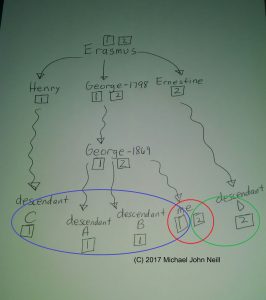
Analyzing DNA matches can sometimes be confusing. One issue is the bits of shared DNA that get passed down through the succeeding generations of the family. The visual with my ancestor Erasmus Trautvetter’s simplifies the genetic process, but serves to illustrate what potentially could happen.
Among all the DNA Erasmus had in his body, let’s focus on two chunks: chunk 1 and chunk 2. Only chunk 1 is passed down to son Henry. Chunks 1 and 2 are passed down through son George and chunk 2 is passed down through daughter Ernestine. Henry passes chunk 1 to one of his descendants. George’s chunk and 2 are passed down through several generations until another George. The second George passed chunk 1 down to all of his descendants, but I am the only descendant of the second George who got chunks 1 and 2. Ernestine passed down chunk 2 to one of her descendants.
For that reason, all of us in the current DNA are not matches for each other. Those of us with chunk 1 all match. Those of us with chunk 2 all match. But the descendants with only chunk 1 in their DNA will not see the descendants with only chunk 2 in their DNA.








4 Responses
I like the visuals. I have 4 children. All 4 took different aspects of my/father’s DNA and look very different too. My youngest daughter got most my Italian/Greek. Her husband is Irish. Their son is predominantly my Scottish side! I told them, Evan is more mine then yours 🙂
Thank you Michael, this an excellent way of describing the vagaries of genetic inheritance to someone unfamiliar with the whole thing.
You are welcome. Personally there are times when I think that people make certain parts of the DNA analysis more difficult than it needs to be. Not that there are not technical aspects that can be challenging–there are. But a grasp of the basic concepts is often enough to make significant headway in analyzing a person’s results.
Thanks for the description. A few years ago I saw or read where a set of triplets were tested. Two were pretty similar in their dna but the third was like from a different womb.